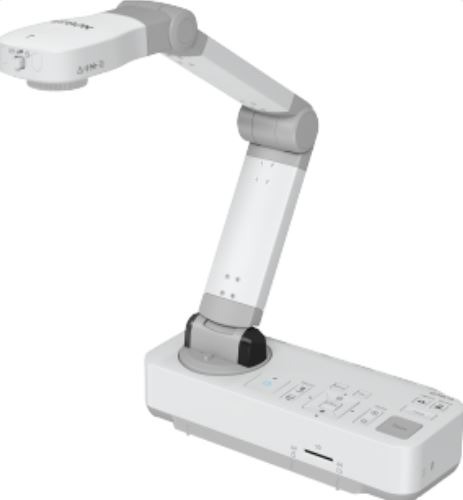A visualiser lets you display a non-digital item digitally on a screen or monitor, bringing a new dimension to classroom learning and presentations.
Unlike projectors, visualisers display 2D and 3D objects in their raw formats. For example, you could place an orange on a visualiser and zoom in on the surface to show the pits and textures on a screen without any prep.
The Epson ELPDC13 Visualiser is an entry-level visualiser designed to be lightweight and transportable. It has no optical zoom (only digital zoom), but that’s the only caveat for the price. Otherwise, it’s a great visualiser for classrooms.
Epson ELPDC13 Visualiser Specs
- Zoom: Digital zoom x16
- Focus: Auto
- Shooting area: A3 (297 x 420 mm)
- Resolution: Up to 1080p (1920×1080)
- Connectivity: HDMI out, VGA out, VGA in, USB 1.1 Type B, SD card
- Security: Kensington lock, security bar, security cable hole
- Image/video features: Autofocus, freeze, parallel view, split-screen
- Software: Easy Interactive Tools, TWAIN driver for Epson Document Camera (for Windows)
Review
The ELPDC13 has a CMOS sensor, which means it is geared up to capture still images and video. This makes it great for documents and static objects.
Some CMOS sensors can struggle with moving objects when video streaming, but we’re pleased to report that isn’t the case here, with the ELPDC13’s fast autofocus and lens letting you stream without motion blur at 30 frames per second.
The quality is great, bringing a new dimension to the classroom.
Zoom
The only downside to the ELPD13 is the digital zoom. We prefer optical. Digital zoom magnifies a portion of an image, thus capturing fewer pixels, which results in a loss of quality in the image the further you zoom in.
The zoom is better than nothing, but if you want to maintain a perfectly crisp image at full zoom, you’ll want a visualiser with optical zoom.
Resolution
There are no complaints with the resolution. The ELPDC13 displays a crisp 1080p video and captures stills in the same resolution.
The complete resolutions include: SXGA(1280*1024)/XGA(1024*768)/WXGA 16:10 (1280*800)/WXGA 16:9 (1360*768)/1080p (1920*1080), 480p/ 720p/ 1080p. You’ll use a different resolution to suit the monitor or display.
Ease of use
We really like the split-screen mode on the ELPD13, which lets you display two documents or objects side by side with a live video feed and image capture.
We also like the rotating camera head, which lets you rotate the camera 180 degrees to stream what’s in front of you, or on the table.
There’s also a microscope mode, which optimises the camera settings for use with a microscope (useful for science lessons).
Setting up the Epson ELPD13 is as easy as plugging it in, connecting a device to display the content and running through a quick setup.
Once set up, you can transport the visualiser from room to room.
It connects to a laptop, PC or Mac via USB (there’s also HDMI out for TVs, and VGA out, VGA in for older monitors) and once it connects you’re good to go. You can also insert an SD card for storage, which it recognises automatically.
Overall
The ELPD13 is perfect for classrooms and general use. It’s lightweight, easy to use and displays a crisp, full HD image. The only downside is the lack of optical zoom (digital only), but we can forgive it for the price. We rate it a solid 8.5 out of 10.



